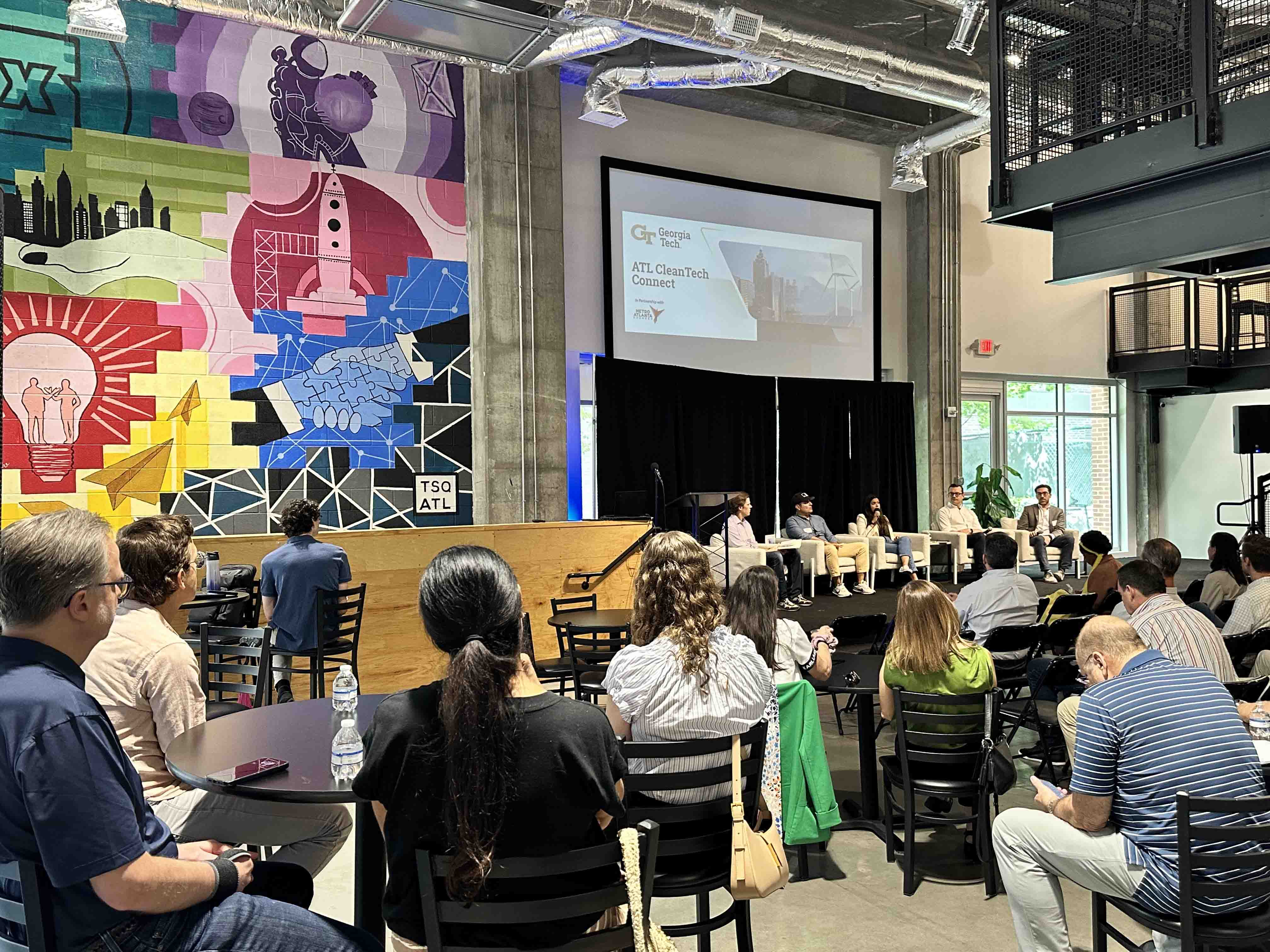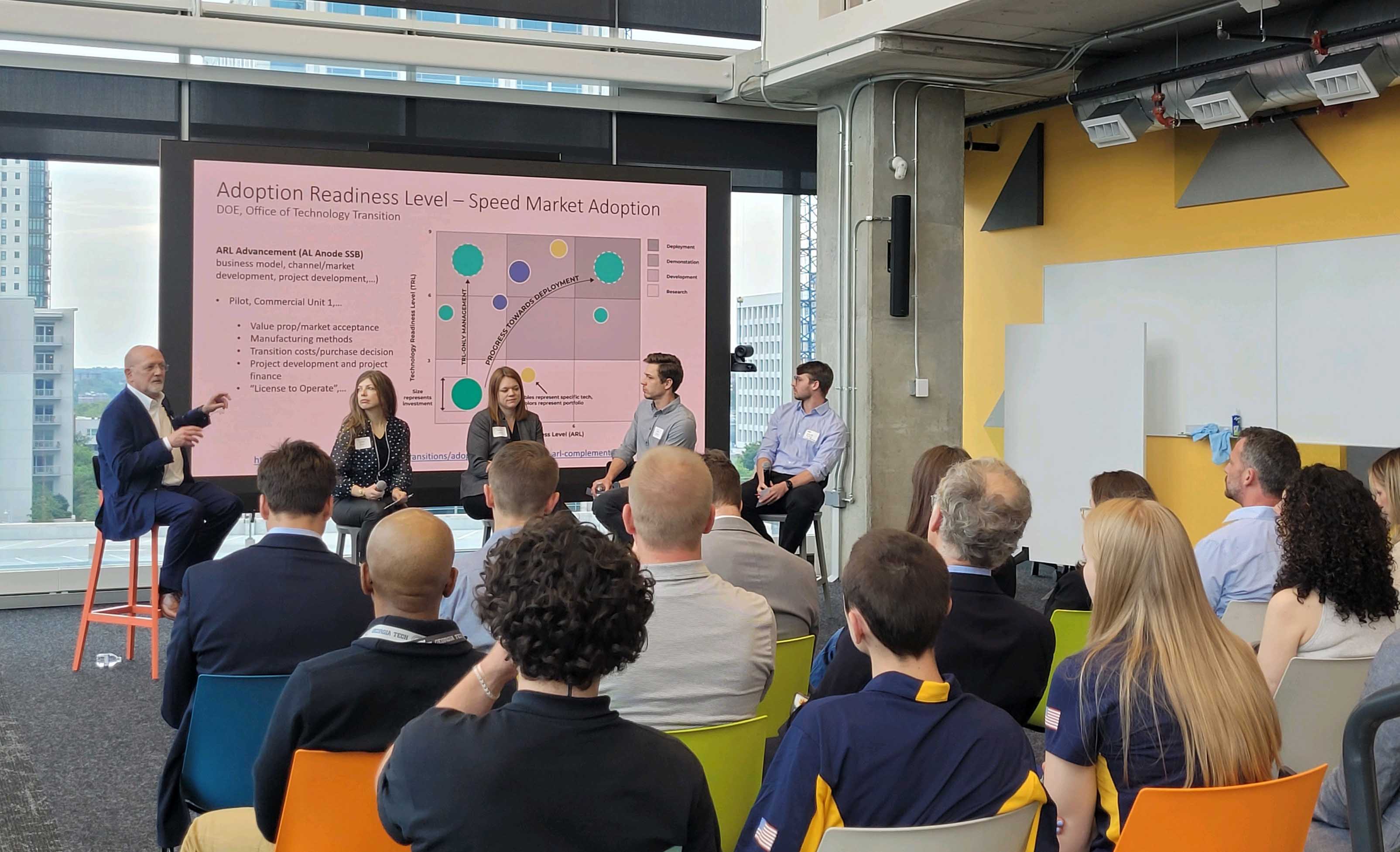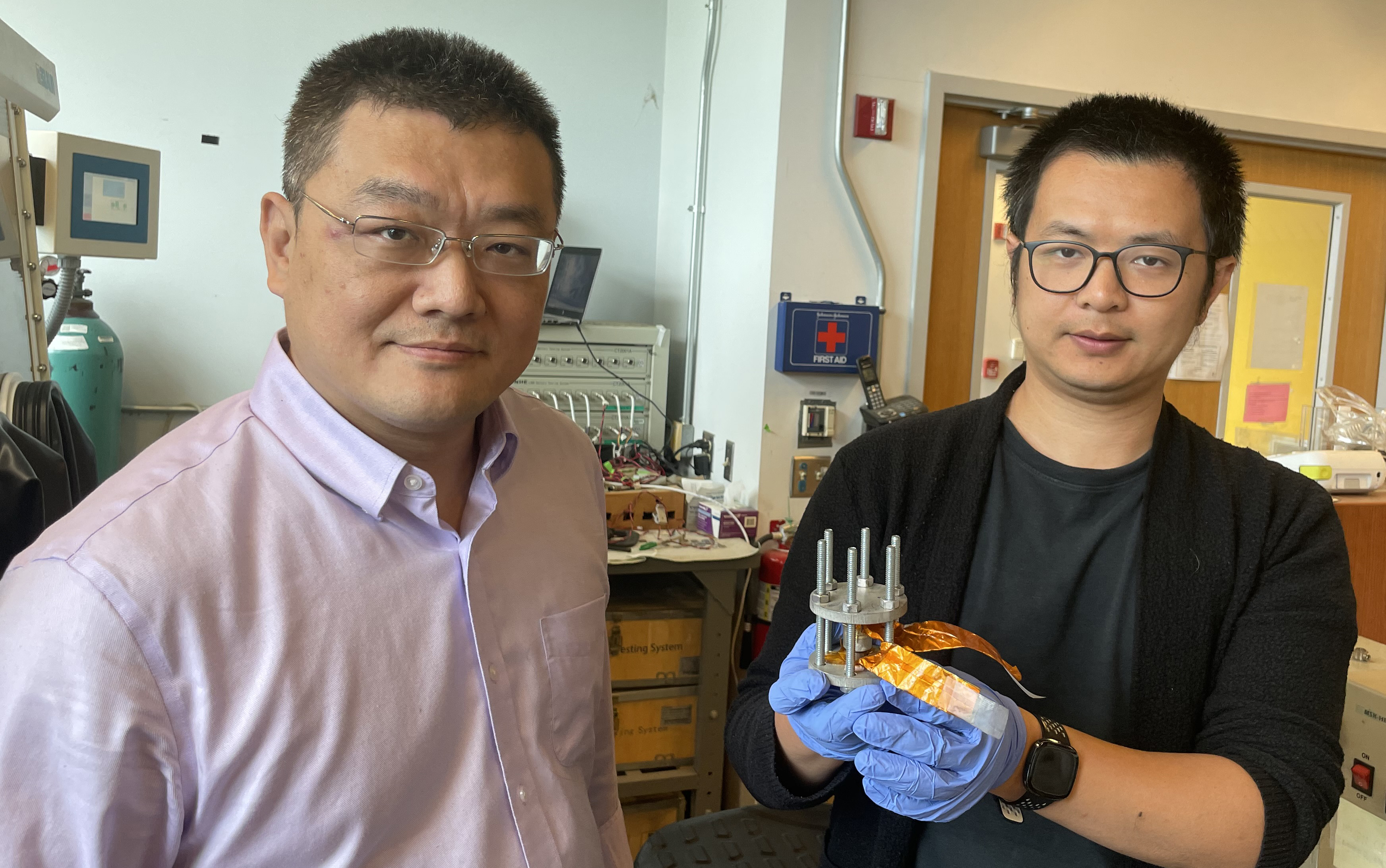Atlanta's Surge in Clean Tech: A Model for National Leadership
Sep 24, 2024 — Atlanta, GA

The inaugural ATL CleanTech Connect held at the CODA building; Panelists include Tim Lieuwen, Executive Director, Strategic Energy Institute, Bill Nussey, Partner, Engage and Tech Square Ventures, Anthony Oni, Managing Partner, EIP Elevate Future Fund, and Andrea Pinabell, Vice President, RE Tech Advisors
When the City of Atlanta adopted the Clean Energy Atlanta resolution in 2019, setting an ambitious goal to achieve 100% clean energy by 2035, few could have predicted the rapid progress the city would make toward becoming a national leader in clean tech innovation. By 2023, the Atlanta clean energy community had coalesced into a powerhouse of innovation, driving the city closer to its clean energy goals.
In January 2024, the launch of the Atlanta CleanTech Connect social marked a pivotal moment in this journey. Co-sponsored by the Metro Atlanta Chamber (MAC) and Georgia Tech’s Strategic Energy Institute (SEI), this event has quickly become a must-attend gathering for Atlanta’s clean energy leaders. Drawing participants from the startup and VC ecosystem, industry, government, academia, and the nonprofit sector, the social serves as a hub for those eager to learn about and contribute to Atlanta’s clean energy future.
Past socials have been well-received, selling out weeks in advance. Attendees have requested a monthly rather than quarterly social. The event format encourages in-depth discussion about clean energy topics and cleantech startup avenues and fosters valuable networking opportunities among professionals united by a common goal: achieving a 100% clean energy future enabled by starting and rapidly growing successful cleantech companies in Atlanta.
“Atlanta CleanTech Connect is a direct result of SEI’s strategic priority to facilitate conversations that result in trusted relationships between innovators, proven entrepreneurs, potential customers, and cleantech investors, all of whom are critical to speed Atlanta startups’ time-to-market. The ultimate goal is for Atlanta to be recognized globally as a top cleantech startup hub, which we can only achieve by rapidly building and scaling more exceptional cleantech companies here at home,” said Richard Gruber, SEI’s senior fellow. Along with Cynthia Curry, senior director of Cleantech Ecosystem Expansion with the Metro Atlanta Chamber, Gruber plays an integral role in creating the social — from choosing the topics to assembling the moderators and panels that have made the event a great success.
The topics covered at these socials have been both timely and important. Discussions have ranged from "Financing Cleantech Hardtech Startups" and "Decarbonization of the Built Environment" to “Innovations in Sustainable Aviation,” offering insights that are crucial for the advancement of clean technologies. These events, held quarterly, will continue into 2025, and the next gathering is scheduled for Wednesday, Oct. 16.
Atlanta is rapidly evolving into a national leader in electric vehicles, next-generation batteries, sustainable fuels, and advanced solar technologies. Since 2018, companies have invested over $11.5 billion in these sectors across Georgia, with the greater Atlanta region at the epicenter of this activity. By facilitating opportunities for the region’s cleantech experts to connect, network, and share knowledge, the Atlanta CleanTech Connect socials are helping to forge the relationships that will support the continued growth of Atlanta’s cleantech startups.
Miguel Granier, managing director of the new Cox Cleantech Accelerator, explained the importance of these gatherings. “Before the ATL CleanTech Connect events, there wasn’t a regular platform where I could connect with other leaders and supporters of cleantech innovation in Atlanta. Cleantech spans multiple industries, so many of us don’t cross paths regularly. We need events like these to bring us together, building relationships that strengthen the entire ecosystem.”
Atlanta CleanTech Connect stands out among the city’s clean technology initiatives for its emphasis on relationship-building as a tool for supporting and expanding the cleantech ecosystem. Other major initiatives, such as the Georgia Cleantech Innovation Hub and the Cox Cleantech Accelerator, have focused on helping individual businesses overcome barriers to success. Together, these complementary approaches have cultivated a robust clean energy ecosystem in Atlanta, making it an attractive destination for clean energy startups and capital investment firms.
Written by: Sharon Murphy, Research Associate at the Strategic Energy Institute

ATL CleanTech Connect Social at the Clubhouse in the heart of Tech Square in Atlanta - July 17, 2024

The April ATL CleanTech Connect brought in speakers to discuss the topic "Financing Cleantech Hardtech Startups." Speakers include Will Thorburn, AVP, Cleantech Strategy and Investments, Cox Enterprises, Henk Both, Investment Director, Anzu Partners, Carie Davis, Partnerships Principal, Third Derivative, and Nick Fragnito, Partner, Shorewind Capital
Priya Devarajan || SEI Communications Program Manager
Written by: Sharon Murphy, Research Associate at the Strategic Energy Institute
New Battery Cathode Material Could Revolutionize EV Market and Energy Storage
Sep 22, 2024 — Atlanta, GA

Zhantao Liu with the new low-cost cathode that could revolutionize lithium-ion batteries and the EV industry. Photo by Jerry Grillo
A multi-institutional research team led by Georgia Tech’s Hailong Chen has developed a new, low-cost cathode that could radically improve lithium-ion batteries (LIBs) — potentially transforming the electric vehicle (EV) market and large-scale energy storage systems.
“For a long time, people have been looking for a lower-cost, more sustainable alternative to existing cathode materials. I think we’ve got one,” said Chen, an associate professor with appointments in the George W. Woodruff School of Mechanical Engineering and the School of Materials Science and Engineering.
The revolutionary material, iron chloride (FeCl3), costs a mere 1-2% of typical cathode materials and can store the same amount of electricity. Cathode materials affect capacity, energy, and efficiency, playing a major role in a battery’s performance, lifespan, and affordability.
“Our cathode can be a game-changer,” said Chen, whose team describes its work in Nature Sustainability. “It would greatly improve the EV market — and the whole lithium-ion battery market.”
First commercialized by Sony in the early 1990s, LIBs sparked an explosion in personal electronics, like smartphones and tablets. The technology eventually advanced to fuel electric vehicles, providing a reliable, rechargeable, high-density energy source. But unlike personal electronics, large-scale energy users like EVs are especially sensitive to the cost of LIBs.
Batteries are currently responsible for about 50% of an EV’s total cost, which makes these clean-energy cars more expensive than their internal combustion, greenhouse-gas-spewing cousins. The Chen team’s invention could change that.
Building a Better Battery
Compared to old-fashioned alkaline and lead-acid batteries, LIBs store more energy in a smaller package and power a device longer between charges. But LIBs contain expensive metals, including semiprecious elements like cobalt and nickel, and they have a high manufacturing cost.
So far, only four types of cathodes have been successfully commercialized for LIBs. Chen’s would be the fifth, and it would represent a big step forward in battery technology: the development of an all-solid-state LIB.
Conventional LIBs use liquid electrolytes to transport lithium ions for storing and releasing energy. They have hard limits on how much energy can be stored, and they can leak and catch fire. But all-solid-state LIBs use solid electrolytes, dramatically boosting a battery’s efficiency and reliability and making it safer and capable of holding more energy. These batteries, still in the development and testing phase, would be a considerable improvement.
As researchers and manufacturers across the planet race to make all-solid-state technology practical, Chen and his collaborators have developed an affordable and sustainable solution. With the FeCl3 cathode, a solid electrolyte, and a lithium metal anode, the cost of their whole battery system is 30-40% of current LIBs.
“This could not only make EVs much cheaper than internal combustion cars, but it provides a new and promising form of large-scale energy storage, enhancing the resilience of the electrical grid,” Chen said. “In addition, our cathode would greatly improve the sustainability and supply chain stability of the EV market.”
Solid Start to New Discovery
Chen’s interest in FeCl3 as a cathode material originated with his lab’s research into solid electrolyte materials. Starting in 2019, his lab tried to make solid-state batteries using chloride-based solid electrolytes with traditional commercial oxide-based cathodes. It didn’t go well — the cathode and electrolyte materials didn’t get along.
The researchers thought a chloride-based cathode could provide a better pairing with the chloride electrolyte to offer better battery performance.
“We found a candidate (FeCl3) worth trying, as its crystal structure is potentially suitable for storing and transporting ions, and fortunately, it functioned as we expected,” said Chen.
Currently, the most popularly used cathodes in EVs are oxides and require a gigantic amount of costly nickel and cobalt, heavy elements that can be toxic and pose an environmental challenge. In contrast, the Chen team’s cathode contains only iron (Fe) and chlorine (Cl)—abundant, affordable, widely used elements found in steel and table salt.
In their initial tests, FeCl3 was found to perform as well as or better than the other, much more expensive cathodes. For example, it has a higher operational voltage than the popularly used cathode LiFePO4 (lithium iron phosphate, or LFP), which is the electrical force a battery provides when connected to a device, similar to water pressure from a garden hose.
This technology may be less than five years from commercial viability in EVs. For now, the team will continue investigating FeCl3 and related materials, according to Chen. The work was led by Chen and postdoc Zhantao Liu (the lead author of the study). Collaborators included researchers from Georgia Tech’s Woodruff School (Ting Zhu) and the School of Earth and Atmospheric Sciences (Yuanzhi Tang), as well as the Oak Ridge National Laboratory (Jue Liu) and the University of Houston (Shuo Chen).
“We want to make the materials as perfect as possible in the lab and understand the underlying functioning mechanisms,” Chen said. “But we are open to opportunities to scale up the technology and push it toward commercial applications.”
CITATION: Zhantao Liu, Jue Liu, Simin Zhao, Sangni Xun, Paul Byaruhanga, Shuo Chen, Yuanzhi Tang, Ting Zhu, Hailong Chen. “Low-cost iron trichloride cathode for all-solid-state lithium-ion batteries.” Nature Sustainability.
FUNDING: National Science Foundation (Grant Nos. 1706723 and 2108688)

Hailong Chen and Zhantao Liu present a new, low-cost cathode for all-solid-state lithium-ion batteries. Photo by Jerry Grillo
Tim Lieuwen Honored by Royal Academy of Engineering
Sep 18, 2024 — Atlanta, GA

Professor Tim Lieuwen has been elected to the status of International Fellow by the U.K.’s Royal Academy of Engineering. He is one of three U.S. engineers to receive this prestigious fellowship, which emphasizes enhancing the role of engineering in society and developing an inclusive future through research, education initiatives, and industry collaborations.
Lieuwen is a Regents’ Professor, the David S. Lewis, Jr. Chair in the Daniel Guggenheim School of Aerospace Engineering (AE), a member of the National Academy of Engineering, and a fellow of the American Society of Mechanical Engineers and the American Institute of Aeronautics and Astronautics, among several others. For 12 years, he served as executive director of the Strategic Energy Institute; he is currently serving as Georgia Tech’s interim executive vice president for Research.
“Tim Lieuwen’s groundbreaking research and leadership have been instrumental in advancing the AE School’s mission,” said Mitchell Walker, AE chair. “His work in combustion dynamics, propulsion, and clean energy systems not only enhances our academic reputation but also drives significant, real-world impact, as recognized by the Academy.”
Lieuwen’s research focuses on developing clean combustion technologies for power generation and propulsion. He works closely with industry and government professionals to address energy concerns and set the standard for clean tech manufacturing. The Georgia Tech alumnus will formally be admitted to the Academy at a special ceremony in London on November 27, 2024.
The 2024 class includes 60 Fellows, six International Fellows, and five Honorary Fellows, each of whom has made exceptional contributions to their own field, pioneering new innovations, leading progress in business or academia, providing high-level advice to government, or promoting wider understanding of engineering and technology.
kelsey.gulledge@aerospace.gatech.edu
SEI and GTRI Announced Awardees for Seed Funding From the Energy and National Security Workshop
Sep 17, 2024 — Atlanta, GA

This Summer, the Strategic Energy Institute and GTRI jointly created the Energy and National Security Initiative through an inaugural workshop on July 16.
The initiative included Phase 1 or Category A grants that allowed researchers up to $10,000 in seed funding to understand the viability of their research concepts. The multidisciplinary proposals that won the Category A grants include:
| Project Title | Primary Investigator(s) | Other Investigators |
| Energy Infrastructure Security and Risk Assessment Through Interactive Wargaming | Dimitri Mavris (Aerospace Engineering) Scott Duncan (Aerospace Engineering) Michael Balchanos (Aerospace Engineering) | Adam Stulberg (International Affairs) Jenna Jordan (International Affairs) Margaret Kosal (International Affairs) |
| International Workshop on Nuclear Cybersecurity: Strengthening Global Leadership and Collaboration | Fan Zhang (Nuclear and Radiological Engineering) Steve Biegalski (Nuclear and Radiological Engineering) Valerie Thomas (ndustrial and Systems Engineering) Alexander Miranda (Electrical and Computer Engineering) | Guenevere Chen (Electrical and Computer Engineering, University of Texas, San Antonio) |
| Robust Energy Systems Planning by way of Novel Systems Engineering (RESPoNSE) | Comas Haynes (GTRI) | Matt McDowell (Mechanical Engineering, Materials Science and Engineering) |
| Shielding and Microreactor Arrangement Innovation (Samμrai) | John Brittingham (GTRI) Bojan Petrovic (Mechanical Engineering) | Helen Works (GTRI) |
| The Strategic Mineral Economy: Challenges and Opportunities for Critical Resources | Bobby Harris (Economics) Matthew Swarts (GTRI) | Dylan Brewer (Economics) Kevin Caravati (GTRI) Laura Taylor (Economics) Micah S. Ziegler (Chemical and Biomolecular Engineering, Public Policy) |
| Trustworthy AI for Critical Power Grid Infrastructure Resilience | Glen Chou (Cybersecurity and Privacy) Yatis Dodia (GTRI) Saman Zonouz (Cybersecurity and Privacy, Electrical and Computer Engineering) |
Phase 2 or Category B of the initiative includes up to $500,000 in seed funding to fund team research proposals, with funds likely to grow to $1.2 million in the coming years. Please note that teams must largely consist of those who participated in or expressed interest via the July workshop.
Georgia Tech researchers and faculty are encouraged to submit the Notice of Intent for Phase 2 (Category B) submissions. While this is not a requirement of the proposal, it will provide the initiative with insights that will help with internal logistics. If you have any questions regarding the Category B Notice of Intent and the grant, please contact the Strategic Energy Institute at connect@energy.gatech.edu.
Priya Devarajan || SEI Communications Program Manager
Strategic Energy Institute's 20th Anniversary Celebrations
Please join us to celebrate the 20th anniversary of the Strategic Energy Institute (SEI) at Georgia Tech. The celebration includes:
Professor Christopher W. Jones Wins ACS Murphree Award
Sep 13, 2024 —

Chris Jones
Professor Christopher W. Jones, the John F. Brock III School Chair of Georgia Tech’s School of Chemical and Biomolecular Engineering (ChBE), is winner of the American Chemical Society’s 2025 E. V. Murphree Award in Industrial and Engineering Chemistry.
Jones will receive the award at the American Chemical Society (ACS) meeting in San Diego, in March 2025. The ACS National Awards encourage the advancement of chemistry in all its branches, support research endeavors, and promote the careers of chemists.
The Murphree Award (including $5,000) won by Jones recognizes fundamental research in industrial and engineering chemistry, the development of chemical engineering principles, and its application to industrial processes.
Srinivas Garimella Receives 2024 ASME Heat Transfer Memorial Award
Aug 14, 2024 — Atlanta, GA

Srinivas Garimella Receives ASME Heat Trasnfer Memorial Award
Srinivas Garimella, Hightower Chair in Engineering and professor in the George W. Woodruff School of Mechanical Engineering, has been awarded the 2024 American Society of Mechanical Engineers (ASME) Heat Transfer Memorial Award.
The Heat Transfer Memorial Award, established in 1959 by the Heat Transfer Division and elevated to a Society award in 1974, is bestowed on individuals who have made outstanding contributions in the field of heat transfer through teaching, research, practice, design, service, leadership, and inventions.
"It is very gratifying to receive this recognition from the premier heat transfer research community," said Garimella.
Garimella joined Georgia Tech in 2003 as an associate professor and director of the Sustainable Thermal Systems Laboratory. His research includes sustainable energy systems, such as absorption and vapor compression heat pumps, waste heat recovery and upgrade, electrochemical and thermochemical energy storage, power plant cooling, advanced nuclear reactor thermalhydraulics, and water conservation and purification.
Associate Professor Matthew McDowell Selected for Emerging Leaders Program
Aug 23, 2024 — Atlanta, GA

Matthew McDowell
Matthew McDowell, Carter N. Paden, Jr. Distinguished Chair and associate professor in the George W. Woodruff School of Mechanical Engineering, has been selected to participate in Georgia Tech’s Emerging Leaders Program. He is among 16 faculty members who will join the program’s ninth cohort.
“On behalf of Institute leadership, we are proud to welcome the next cohort of the Emerging Leaders Program,” said Steven W. McLaughlin, provost and executive vice president for Academic Affairs. “Opening the program to a broader pool of individuals, including our talented research faculty, has been an important programmatic expansion as we seek to foster the leadership aspirations of faculty of all paths. This intensive program is an excellent professional investment, and we applaud the new cohort’s commitment to their careers and to the Institute.”
Starting in Fall 2024 and continuing through Spring 2025, McDowell and other participants will take part in leadership development activities that include a kick-off retreat, regular workshops, small group work, and leadership coaching.
Professor Krista Walton Wins 2024 AIChE Award for Excellence in Industrial Gases Technology
Aug 29, 2024 — Atlanta, GA
Professor Krista Walton was selected as the recipient of the 2024 Institute Award for Excellence in Industrial Gases Technology from the American Institute of Chemical Engineers (AIChE).
Walton, Georgia Tech’s associate vice president for Research Operations and Infrastructure and the Robert "Bud" Moeller Faculty Fellow in Georgia Tech’s School of Chemical and Biomolecular Engineering (ChBE), will receive the award at the AIChE meeting in San Diego, California, this October.
Walton focuses her research on the synthesis, characterization, and scale-up of metal-organic frameworks (MOFs) and other porous materials for adsorption-based gas separations.
Starting more than a decade ago, Walton became one of the few researchers in the world to focus on understanding the chemical stability of MOFs and has gained an international reputation for her work by helping shape the landscape of MOF applications in separations. She has published more than 135 peer-reviewed articles, including a seminal review on the water stability of MOFs in 2014.
Meisha Shofner Selected for ELATES National Leadership Program
Aug 28, 2024 — Atlanta, GA

Meisha Shofner ELATES Fellow 2024-2025
Meisha Shofner, professor in the School of Materials Science and Engineering (MSE), has been selected for the 2024-2025 class of Drexel University’s Executive Leadership in Academic Technology, Engineering and Science (ELATES) program.
The ELATES program is a national leadership development program designed to promote women in academic STEM fields and faculty allies of all genders into institutional leadership roles.
“I am excited to be selected as an ELATES Fellow. I am grateful for the support from Georgia Tech’s College of Engineering that made this opportunity possible and especially support from Dean Raheem Beyah, Associate Dean Kim Kurtis, and MSE School Chair Natalie Stingelin. I am looking forward to learning from this amazing community of women leaders in higher education,” Shofner said.
“I was drawn to the ELATES program because of its focus on developing the skills needed to lead university initiatives with an operational focus, and I will be putting that knowledge into practice as I develop an institutional action project as part of the program.”
